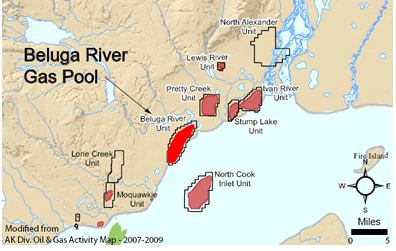
As state officials ready for a special session on natural gas, Anchorage is moving one step closer to expanding ownership over nearby gas fields in upper Cook Inlet.
On Tuesday, the city’s Assembly voted to let a new energy proposal advance: It’s an early step that gives Mayor Ethan Berkowitz’s administration permission to submit a bid by week’s end. City officials are interested in potentially purchasing a group of three leases from ConcoPhillips, including all of the North Cook Inlet Unit, a third of the Beluga River Unit, and 5,700 acres of various lands “in and around Cook Inlet.”
Anchorage already owns a third of the Beluga River Unit through it’s electric utility ML&P. That purchase happened in 1996, under the administration of Mayor Rick Mystrom. according to Assembly Member Tim Steele, chair of the committee overseeing utilities.
“ML&P had an opportunity to gain a stable gas supply for its gas fired plants,” said Assembly Member Tim Steele, chair of the Enterprise Oversight Committee.
According to documents submitted by the administration, the $120 million purchase has conservatively saved rate payers at least $239 million that amount over the last two decades.
So far, discussions over the proposed purchase have taken place behind closed doors, in order to protect the municipality’s chances in the competitive bidding process.
According to Steele, its uncommon among cities to own energy-producing resources like a gas field. For rate-payers and the utility, gas coming online from the Beluga River lease is a “substantial part” of powering Anchorage.
“We have a number of sources for electrical generation–including hydro, but in terms of our natural gas-fired plants we get all our gas out of that investment,” Steele said.
If the new units are eventually acquired, the Administration expects they’ll produce more natural gas than ML&P currently needs. That could meant the municipality is required to sell off extra gas or excess energy at market rate.
Any purchase will have to be first be approved by the Assembly.
Zachariah Hughes reports on city & state politics, arts & culture, drugs, and military affairs in Anchorage and South Central Alaska.
@ZachHughesAK About Zachariah




